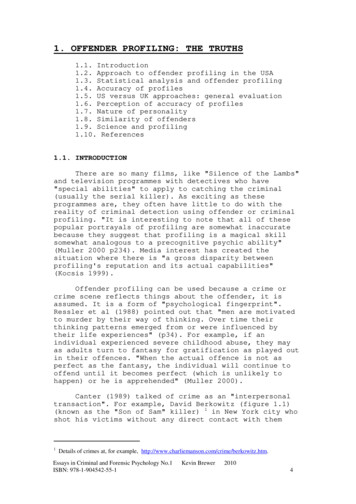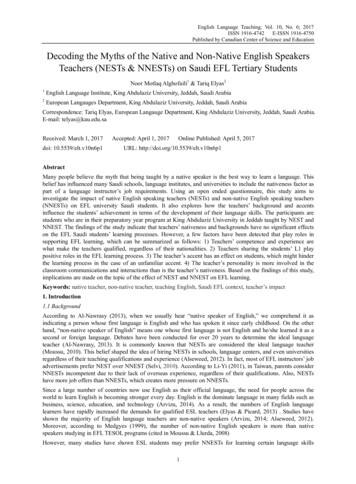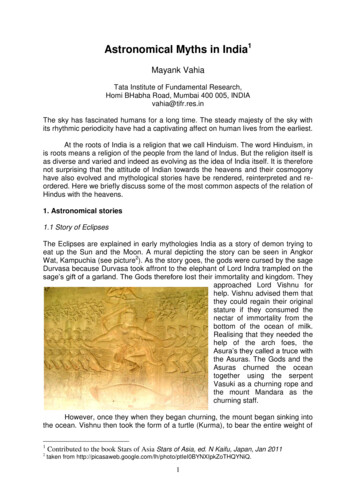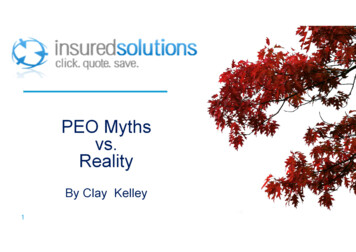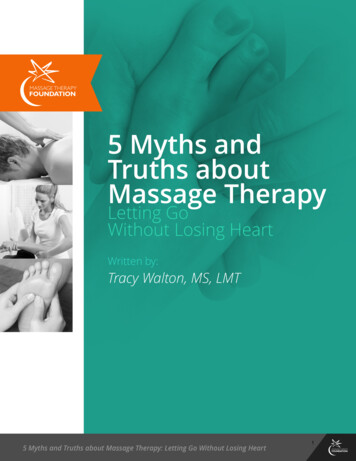
Transcription
5 Myths andTruths aboutMassage TherapyLetting GoWithout Losing HeartWritten by:Tracy Walton, MS, LMT5 Myths and Truths about Massage Therapy: Letting Go Without Losing Heart1
Part 1: A StoryThe physician on my table wanted to chat for the first few minutes of his massage.It was early in my career, and I was seeing him at a well-known spa. He was a bigfan of massage therapy and knew many people I knew. He had hired MTs and recommended them to his patients. Our conversation took a turn when he said:“Even though I really see the value of massage therapy, there’s one thing that massage therapists say, one word you all use, that has always bugged me.”“What word is that?”“Toxin.”“Toxin?”“Yes. Toxin.”There was silence for a bit as I thought about this. Then we talked some more: Howvague the term is. How no one seems to know what it really means, but the idea of“detoxification” has great appeal. He said most any substance in the body is toxic attoo high a level. He said the word “toxin” doesn’t have much meaning, the way it isused in massage therapy.That conversation took place more than 20 years ago. I came away from it with adesire to be thoughtful in my claims about massage.Much has been learned since then about the effects of massage, but much is still amystery. In this rapidly developing field, new ideas and information are growing.5 Myths and Truths about Massage Therapy: Letting Go Without Losing HeartPage 1
Some old ideas are being cleared away so that the profession can moveforward. As an oncology massage therapist, I can tell you thatshedding the “massage spreads cancer” myth opened up whole new frontiers forclients and therapists alike.The growth in information serves our profession. As massagetherapists, we value good information. We want to pass on thebest, most accurate data about the effects of massage. In particular, we want to be as clear as we can about commonly heldbeliefs. Among these are the effects of massage on: Endorphins Immunity Cortisol Blood circulation “Toxins” and toxin releaseIn this e-book, we look at each one of these factors and check our assumptionsagainst the best available evidence.WHY? THERE ARE GOOD REASONS TO CHALLENGE OUR BELIEFS ABOUT MASSAGE.5 Myths and Truths about Massage Therapy: Letting Go Without Losing HeartPage 2
‣Ethics. We have an ethical responsibility to make accurateclaims about massage therapy. False claims are a serious breachof ethics in any profession.‣Avoiding embarrassment. If we are called out on a claim wemake, and it is found to be untrue, it casts doubt on other, wellestablished benefits of massage! Inaccurate statements reflectpoorly on the profession, so that our work is not taken seriously.‣Moving massage forward. We are more likely to moveour profession forward and earn a role in healthcareif we are sharing the truth about our work.‣Staying current. Healthcare providers update knowledge regularly. So should we.‣Keeping it simple. Massage is wonderful in so manyways. It can sell itself. We don’t need to grasp at shakystatements to try and oversell it.5 Myths and Truths about Massage Therapy: Letting Go Without Losing HeartPage 3
Part 2: Why It’s So Hard to Let Go of Old ClaimsFor decades, we have passed along a lengthy list of massage benefits. These claimshave helped us promote and justify our work, so we’ve leaned heavily on them forcredibility. When bits of research started to emerge, seeming to support these veryfoundations of massage therapy, we celebrated.But it’s been challenging to keep a good, accurate list of massage effects or outcomes. Why? There are many reasons. Massage was taught in an “oral history” fashion for many decades, without scrutiny for the many claims we made. There wasn’ta lot of literature, and very little research on massage. Our field does not havemany educators who are research-literate, so that research hasn’t gotten into theclassroom.Those things are changing, and that’s good news. But a couple of points of confusion have clouded our understanding of massage therapy:PROBLEM 1: WE CONFUSE TWO TYPES OF MASSAGE OUTCOMES.Clinical outcomes and mechanistic outcomes are different.What are Clinical Outcomes?A clinical outcome is a change in a patient’s signs and symptoms, mental state, orability to cope. Clinical outcomes are changes in the effects of a disease, injury, orexercise on how a person functions. A clinical outcome tells us whether massagehelps or “works.”A change in stress level is a clinical outcome.5 Myths and Truths about Massage Therapy: Letting Go Without Losing HeartPage 4
Clinical outcomes are often measured with client self-reports (“My pain isbetter”), questionnaires, or scales (“My pain is a 3 on a 0-10 scale”). Some are “objective” third-party observations: function, range of motion,results from palpation, athletic performance, or observations by nurses.What are Mechanistic Outcomes?A mechanistic outcome is a change in a biological substance, mechanism, or pathway. A mechanistic outcome or mechanism of action may explain how massageworks. In massage therapy, researchers looking at biochemicalchanges are measuring mechanistic outcomes. Examples of mechanistic outcomes are changes in epinephrine, dopamine, serotonin, blood sugar, endorphinlevels, cortisol, and even changes in gene expression. Mechanistic studies of massage might involve samplesof saliva, blood, urine, or tissue. Ultrasound and other imaging can help us examine mechanisms of action.WE LEAP FROM ONE TO THE OTHERAs massage therapists, we sometimes confuse clinicaland mechanistic outcomes. We leap too quickly from aclinical observation (“massage reduces stress”) to explaining the mechanisms behind it (“massage lowerscortisol”).This muddies our thinking and our communication.Page 5
In massage therapy, mechanistic explanations are often weak or lacking. Often theydon’t really support the clinical outcomes we see. That doesn’t mean massagedoesn’t “work,” it just means it might not work the way we think, or the way we’vebeen taught.And clients rarely ask for mechanistic outcomes!5 Myths and Truths about Massage Therapy: Letting Go Without Losing HeartPage 6
Not so much.Clients usually ask for clinical outcomes!“I need help with my pain.”“I am struggling with sleep.”“I want to run without injuring myself.”“I have lots of stress right now. I need to relax.”Page 7
Better. Focus on the clinical outcomes!Our confusion about clinical outcomes vs. underlying mechanisms has kept us frommoving massage therapy forward. Another problem, involving the research evidence, also has held us back.5 Myths and Truths about Massage Therapy: Letting Go Without Losing HeartPage 8
PROBLEM 2: WE’VE QUOTED MASSAGE STUDIES AS THOUGH ALL OF THEM WEREOF HIGH QUALITY, WITHOUT EVALUATING THE RESEARCH WE ARE USING TOBACK UP OUR CLAIMS.It is hard to get traction or gain credibility with claims that are based on weak research. It’s not always easy to tell which research is strongest. In the next section,we will take a quick look at a few basics for evaluating research.5 Myths and Truths about Massage Therapy: Letting Go Without Losing HeartPage 9
Part 3: All Evidence Is Not Equal.EACH TIME YOU SAY, “A STUDY PROVES THAT MASSAGE IS HELPFUL FOR.[FILLIN THE BLANK],” REMEMBER THIS: One study does not “prove” a point or support a claim. A few small studies do not “prove” a point or support a claim. A large, strong body of evidence from different sources is needed to support a claim. The evidence must show consistent results, based on good research.Health care practices should be informed by strong, systematic research. In choosing a therapy, practitioners consider the direction of evidence (what it is saying) andthe strength if the evidence (the quality of the research). Not all research is equal.Some of the massage research we’ve been quoting for years is neither strong, norconclusive!This is really important. We typically see one study reporting massageeffects, then treat it as fact. It shows up in our trade journals and inour classrooms. It gets repeated in social media and on our websites.The results get trumpeted: “Massage increases this! It reduces that! Ithelps with this problem and that problem!” without mentioning theweaknesses or limitations of the study.This used to be understandable, because we had so little research to start with, butwe’ve grown since then. There is more literature on the subject, and in the last fewyears, textbooks have emerged, with guidelines for evaluating emerging massageresearch.15 Myths and Truths about Massage Therapy: Letting Go Without Losing HeartPage 10
For a massage claim to be accurate, it needs to be supported at the highest, strongest level of evidence, not just a small or poorly executed study. There are several factors in the evaluation of research and plenty of places to learn about them (see “Resources” at the end of this book). We will focus on just one factor here:WHAT ARE THE LEVELS OF EVIDENCE, AND WHY DO THEY MATTER TO MASSAGE?Levels of evidence show how medicine and health care define strong and weak evidence, and everything in between.For each of the claims we make about massage: endorphins, immunity, cortisol,blood flow, and toxins; we will look at the level of evidence behind it and what theevidence tells us.There are many levels of evidence, but six main levels are shown here. The strongest evidence is at the top; the weakest is at the bottom. Each level is describedbriefly, below.5 Myths and Truths about Massage Therapy: Letting Go Without Losing HeartPage 11
LEVELS OF EVIDENCETHE ANECDOTE: “AND THEN THIS HAPPENED.”When you tell a single story of a client experience, it is called an anecdote. A clientsharing that story in a public forum is giving a testimonial.“I have a client whose tension headaches disappeared after8 weekly sessions of massage therapy.”“My tension headaches disappeared after 8 weeks of massage therapy.”Anecdotes are important to share, but they are considered the weakest level of evidence. Just because it happened in one client case does not mean it will happen forothers. There is no way to know for sure whether the improvement is due to massage itself or to some other factor.5 Myths and Truths about Massage Therapy: Letting Go Without Losing HeartPage 12
THE CASE REPORT: WRITE IT DOWN SO YOU DON’T FORGETA case report is a formal, published write-up of a single case. Itis a step above an anecdote, with a detailed client presentation, a description of treatment, and the outcome.Even a published case report is considered one of the weakest levels of evidence,because it describes only a single case. Again, there is no way to be certain thatmassage caused an observed change, or if something else was at play.But case reports are important. They give us a start. More case reports are neededin massage therapy to inspire higher-level research. In order to know what to studynext, we need to hear about what is going on in massage therapy practice.Case reports also help health care providers understand what massage therapylooks like in practice. Published case reports provide an intimate picture that largerscale research does not. If you are interested in sharing a client story via a case report, look up the Massage Therapy Foundation’s many resources on how to writeone, and learn more about the MTF case report contest.THE CASE SERIES: STRENGTH IN NUMBERSA case series is a formal write-up of two or more cases that aresimilar in presentation and massage treatment.“This case series describes three female clients, agerange 45-58, who presented with frequent headaches.”5 Myths and Truths about Massage Therapy: Letting Go Without Losing HeartPage 13
Although a case series is more convincing than a case report or anecdote, it lacksan important feature of the next level of evidence. It lacks a control group.THE RCT: THE GOLD STANDARDThe Randomized, Controlled Clinical Trial (RCT) is sometimes called the “gold standard” of clinical research.In this diagram, you can see that in a massage therapy RCT, a research subject israndomly assigned to either a massage therapy (“active treatment”) group or a control group/comparison group that does not receive massage. Space limits an expla2nation here, but random assignment is important for many reasons.5 Myths and Truths about Massage Therapy: Letting Go Without Losing HeartPage 14
Subjects in the control group receive no intervention at all, or they receive someother intervention, such as personal attention without touch. This control group isessential, so that any outcomes observed in the massage therapy group can be attributed to the massage.In other words, changes and improvements can happen over time for many reasons, whether or not a person receives massage. Because of a control or comparison group, a researcher is more able to determine whether changes are a true effect of massage therapy.Notice in the diagram that the same measurements, for example, of sleep, changein mood, change in function, ROM, and so on, are collected from both groups, andthe two groups’ results are compared at the end.Although the RCT is a “gold standard” in the levels of evidence, it’s still easy to overstate the results. We’ve often pointed at a single study as “proof” of massage benefit. A single RCT does not give us the final word on a research question. Instead,keep climbing to the next levels of evidence.THE SYSTEMATIC REVIEW: SOMEONE GAVE UP THEIR SUMMER TO SUMMARIZE THERESEARCHOne study, or RCT, does not really prove a point, nor do ahandful of studies, even if they are all saying the samething. So even though the RCT is the gold standard, youneed a critical mass of good RCTs, all saying the same thing,to really settle a question, like an effect of massage.5 Myths and Truths about Massage Therapy: Letting Go Without Losing HeartPage 15
In a systematic review, a researcher looks to see whether that critical mass of dataexists. Armed with a
Again, there is no way to be certain that massage caused an observed change, or if something else was at play. But case reports are important. They give us a start. More case reports are needed in massage therapy to inspire higher-level research. In order to know what to study next, we need to hear about what is going on in massage therapy practice. Case reports also help health care providers .
